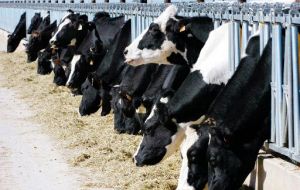MercoPress. South Atlantic News Agency
Dairy produce push FAO food price index one percent higher in March
 The dairy price surge is caused by hot, dry weather in Oceania, which has led to milk production falling off steeply
The dairy price surge is caused by hot, dry weather in Oceania, which has led to milk production falling off steeply The FAO Food Price Index (FPI) crept higher by one percent in March compared with a month before, driven mainly by an 11% increase in dairy. Dairy products carry a 17% weight among the various commodity prices included in the calculation of the overall FPI.
Meanwhile, FAO monitoring of the global cereal supply and demand situation has slightly revised the 2012 crop production estimate upward by nearly 3 million tonnes, which now stands 2% lower than the record set in 2011.
“World cereal production in 2013 could recover strongly barring unfavourable weather in major producing regions,” FAO says in its latest Cereal Supply and Demand Brief. The outlook for all cereal crops is positive overall, with wheat crops already well advanced and plantings for rice and coarse grains expected to increase these coming cropping months owing to attractive prices.
Global wheat production in 2013 is expected to increase by 4% to 690 million tonnes, the second highest ever after the 700 million tonnes produced in 2011.
The FAO Dairy Price Index jumped by 22 points in March to 225, one of the largest recorded changes. The price surge is caused by hot, dry weather in Oceania, which has led to milk production falling off steeply and a concomitant reduction in the processing of dairy products in the region.
The dairy prices used in the Price Index calculation are based on the exports of New Zealand, as it is the world's largest dairy exporter, accounting for about one-third of global trade. Export prices for dairy products have also risen for other important exporters, such as the European Union and the United States, but not to the same degree.
“The exceptional increase is in part a reflection of market uncertainty as buyers seek alternative sources of supply,“ the Food Price Index report says. ”In addition, dairy output in Europe has yet to come fully online after a particularly cold winter, which has delayed pasture growth to feed dairy animals.”
The FAO Cereal Price Index averaged 244 points, unchanged from February. While maize prices increased last month on a fall in exportable supplies from the United States, lower wheat prices on prospects of a good world harvest offset those increases. Global rice prices remained stable.
The FAO Oils/Fats Price Index fell 2.5% from February, due mostly to soy oil prices, which dropped on account of favourable weather conditions in South America, a record 2013 US soybean crop and a cancellation of purchases by China. Palm oil prices were also slightly down.
The FAO Meat Price Index averaged nearly 176 points in March, down 2% from February. The FAO Sugar Price Index edged higher 2.8 points, or one percent, from February.




Top Comments
Disclaimer & comment rulesCommenting for this story is now closed.
If you have a Facebook account, become a fan and comment on our Facebook Page!